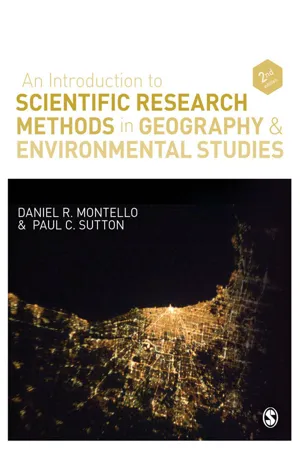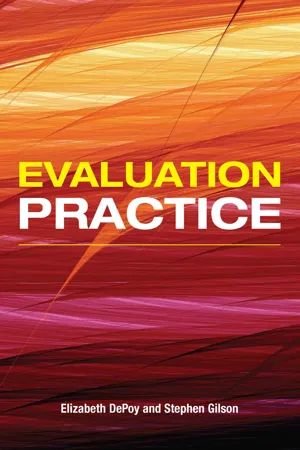Data Analysis
Data analysis involves the process of inspecting, cleaning, transforming, and modeling data to uncover useful information, draw conclusions, and support decision-making. It encompasses a range of techniques and methods, including statistical analysis, machine learning, and data visualization, to extract meaningful insights from datasets.
6 Key excerpts on "Data Analysis"
- Daniel Montello, Paul Sutton(Authors)
- 2012(Publication Date)
- SAGE Publications Ltd(Publisher)
...10 STATISTICAL Data Analysis LEARNING OBJECTIVES How do the graphical and mathematical techniques of Data Analysis help to achieve the four scientific goals of description, prediction, explanation, and control? What are descriptive statistics, and what are the main properties of data sets we might want to describe? What is a statistical relationship, and what are some of the different types of relationships? What are inferential statistics, and what is the basic logic of their two main approaches, estimation and hypothesis testing? What are some of the properties of geo-spatial data that make their analysis particularly rewarding and particularly difficult? Data Analysis is the set of display and mathematical techniques, and attendant logical and conceptual considerations, that allow us to extract meaning from systematically collected measurements of our phenomena of interest and communicate it to others. Data Analysis thus helps us achieve the four scientific goals described in Chapter 1 of description, prediction, explanation, and control. Data Analysis helps to efficiently identify and describe patterns in large amounts of data, patterns that improve our predictions about the unknown, explain the causes of relationships, and allow us to exert influence over phenomena we wish to control. Although we treat them in separate chapters, in practice the display and mathematical techniques of Data Analysis are not entirely separate but make up a single set of procedures for extracting and communicating meaning. In this chapter we discuss the techniques of statistical Data Analysis ; we cover the display techniques, such as mapping and graphing, in Chapter 11. We must emphasize at the outset, however, that the present chapter is not intended to be a detailed tutorial on how to statistically analyze data...
- eBook - ePub
Evaluation Practice
How To Do Good Evaluation Research In Work Settings
- Elizabeth DePoy, Stephen Gilson(Authors)
- 2012(Publication Date)
- Psychology Press(Publisher)
...Appendix: Data Analysis Introduction This appendix presents information to refresh your memory of data analytic concepts and techniques. Basic methods of experimental-type analysis (statistics) and naturalistic analysis (interpretive techniques) are included. Statistical Analysis Statistical analysis is a set of procedures, techniques, and rules that organizes and interprets data. The term data refers to numerical representation of concepts and/or observed phenomena obtained through systematic inquiry. The selection of a statistical procedure is determined by five factors: 1. specific research question(s) to be answered by analysis of the data set; 2. level of measurement; 3. quality of the information collected; 4. sampling procedures used; 5. sample size obtained. Statistical analysis can be categorized into three levels: 1. descriptive—observations reduced and stated in numerical form; 2. inferential—drawing conclusions about population parameters based on findings from a sample selected from the population; 3. associational—identifies relationships between multiple variables and determines the nature of those relationships. Level 1: Descriptive Statistics Basic descriptive statistics describe the characteristics of a set of data. The following is a list of the techniques addressed in this appendix: • frequencies; • central tendencies (mean, mode, and median); • variances; • contingency tables; • correlational analyses. Frequency Distribution D EFINITION Frequency distribution refers to the range of values occurring for a given variable and the number of times each value occurs. H OW TO C OMPUTE Frequency distributions are computed by listing all measured values and counting the number of times each occurs. H OW TO R EPORT Numeric charts, histograms, or bar graphs and polygons (dots connected by lines) are the usual reporting formats...
- eBook - ePub
- David Crowther, Geoff Lancaster(Authors)
- 2012(Publication Date)
- Routledge(Publisher)
...Information, remember, is data which is in a form which can be used for explanation, or more specifically in the context of this book, for decision making. Four key roles for analysis in this respect involve the processes of ‘distillation,’ ‘classification,’‘identification,’ and ‘communication.’ Distillation Most research/consultancy exercises often result in huge amounts of data. Neither the researcher nor the client wants to be faced with a mass of data with the ensuing need to sift through it and try and establish what it all means. A key purpose of analysis, therefore, is to distil potentially large amounts of data into forms that are more readily managed and absorbed, and also discard data that is not appropriate in the context of the research project. At its simplest, this distillation will take the form of summarizing data using, for example, tables, diagrams, or may, alternatively, and in addition, summarize and distil data numerically through measures such as average dispersion, standard deviation, and so on. Failure to distil data effectively is one of the most frequent reasons for failures to understand and implement research findings. Classification Related to the above, Data Analysis should also help to classify data. This involves the grouping of data into categories that allow the researcher and manager to quickly see what factors are involved and potentially what the data means. Classifying data helps to encourage the development of order from chaos. Identification Much Data Analysis is concerned with establishing causes and/or relationships between factors. Data Analysis enables these relationships, and particularly causal relationships to be identified (Krzanowski 1988). Communication The final purpose for analysis involves the important aspect of communicating research findings. It is very difficult to communicate raw data, either to managers in an organization, or to other researchers in a field of inquiry...
- eBook - ePub
- Alan Berkeley Thomas(Author)
- 2004(Publication Date)
- Routledge(Publisher)
...12 Data Analysis and interpretation The range of techniques available for the analysis and interpretation of both quantitative and qualitative data is enormous. A full account of statistical methods alone would fill many volumes. The purpose of this chapter is therefore to provide an overview of the main methods of analysis and to indicate their potential applications rather than to give detailed instruction in how particular statistics are calculated or how to undertake textual interpretation. Guidance to sources dealing with these topics in depth is given at the end of the chapter. Basic processes: describing and explaining Once the dataset has been constructed, its contents must be analysed and interpreted. The accumulated body of data does not speak for itself. At this stage the researcher has to confront two key problems: How can the data be transformed from an extensive assortment of raw materials into a concise and meaningful description of what has been observed? Once a valid and coherent descriptive account has been constructed, how can it be connected with the problem field? Have new descriptive materials been created? Have theoretical expectations been tested? Has a new theory or causal model been constructed? These questions must, of course, be tackled in relation to the overall objectives of the study, but the general aim of analysis and interpretation is to enable the analyst to ‘see the wood for the trees’. The analyst seeks structure in the data: generalities and commonalities within all the variety and the differences that are displayed in the dataset, and linkages, patterns and connections among elements, variables, categories and types. Data can mount up alarmingly as a study progresses: datasets may swell and field notes bulge to the point where it may seem impossible to make any sense out of the material...
- Bonita Kolb(Author)
- 2018(Publication Date)
- Routledge(Publisher)
...The data can then be analyzed using descriptive statistics to find patterns in the responses. Descriptive statistics include frequency, central tendency and dispersion. These statistics will not only describe which responses were most frequently given but also the distribution of responses across the different available answers. Inferential statistics can then be used to determine statistical differences. ● To obtain more information on how the individual responses are distributed from the mean, the researchers will need to use statistical measures of dispersion. These include range, variance and standard deviation. Tests of statistical significance can be used to conduct hypothesis testing. Research analysis process A tourism organization will have spent a considerable amount of time planning the research process including determining the research question and deciding upon the methodology that will best provide the answer. After these two major decisions, the organization then faced the task of finding participants. Finally, the organization conducted the research. After conducting the research, it is now time to analyze the research findings. The excitement of conducting the research is over, and the researchers may be ready to move on to a new project. This would be a mistake as just having data does not answer the research question. Without careful analysis of the data, recommendations cannot be made and the entire research process would be wasted. There may be an assumption that all that is needed is to print out the data and present it in a report. The problem is that people who do not regularly conduct research may not understand the meaning of the data. The research data needs to be interpreted to provide information which can be used to make decisions. The analysis process varies dramatically depending on whether quantitative or qualitative research has been conducted...
- eBook - ePub
I Have the Data... Now What?
Analyzing Data and Making Instructional Changes
- Betsy Moore(Author)
- 2013(Publication Date)
- Routledge(Publisher)
...That means that in order to really analyze data we have to be able to take it apart and scrutinize all the parts. We also have to be able to come to conclusions by inferring, or in other words, by making decisions when things are not specifically spelled out for us. That becomes very difficult for many of us for two reasons; first, we haven’t been trained how to analyze, and second, analysis takes time, and time is something we never have enough of. Data Analysis Process: Six Steps Analysis of data is a skill that takes practice, but it is something that can be done once you understand the steps to doing it. To make it simple, the Data Analysis process has been divided into six steps. They are: Step 1: Displaying the Data in a User-Friendly Way Step 2: Asking Questions about the Data Step 3: Answering Questions Generated from the Data Step 4: Forming Instructional Implications Implied by the Data Step 5: Making Goals to Change the Results of the Data Step 6: Knowing How to Assess the Goals The first three steps of this process will be examined in this chapter. The final three steps comprise the “how” of going beyond the data and will be examined in detail in Chapters 3 and 4. Step 1: Displaying the Data in a User-Friendly Way The first step when it comes to analyzing data is to display it in a way that is easy to read and understand. The information provided in Chapter 1 details how to do this in a way that is concise and clear. The important thing to consider when compiling the data is very simple—what is it that you want to examine? Let’s say that I am a middle school math teacher and I have just been to a conference regarding gender bias and the teaching of math. I am interested in seeing if there is a difference in the way the girls in my math classes perform as opposed to the boys. I would need to compile the data in such a way that I could clearly view what it is I want to know...





